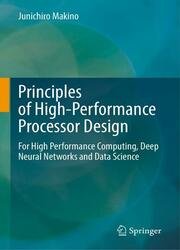Principles of High-Performance Processor Design: For High Performance Computing, Deep Neural Networks and Data Science
- Добавил: literator
- Дата: 21-08-2021, 18:15
- Комментариев: 0
 Название: Principles of High-Performance Processor Design: For High Performance Computing, Deep Neural Networks and Data Science
Название: Principles of High-Performance Processor Design: For High Performance Computing, Deep Neural Networks and Data ScienceАвтор: Junichiro Makino
Издательство: Springer
Год: 2021
Страниц: 167
Язык: английский
Формат: pdf (true), epub
Размер: 11.6 MB
This book describes how we can design and make efficient processors for high-performance computing, AI, and data science. Although there are many textbooks on the design of processors we do not have a widely accepted definition of the efficiency of a general-purpose computer architecture. Without a definition of the efficiency, it is difficult to make scientific approach to the processor design. In this book, a clear definition of efficiency is given and thus a scientific approach for processor design is made possible.
In this book, I tried to theorize what I have learned from my experience of developing special- and general-purpose processors for scientific computing. I started my research career as a graduate student in astrophysics, studying the dynamical evolution of globular clusters. The research tool was the N-body simulation, and it was (and still is) important to make simulations faster so that we can handle larger number of stars. I used vector supercomputers such as Hitac S-810, Fujitsu VP-400, NEC SX-2, Cray X-MP, Cyber 205, and ETA-10, and also tried parallel computers such as TMC CM-2 and PAX. Around the end of my Ph.D. course, my supervisor, Daiichiro Sugimoto, started the GRAPE project to develop special-purpose computers for astrophysical N-body simulations, and I was deeply involved in the development of numerical algorithms, hardware, and software. The GRAPE project is a great success, with hardware achieving 10–100 times better price- and watt-performance compared to general-purpose computers at the same time and used by many researchers. However, as semiconductor technology advanced into deep-submicron range, the initial cost of development of ASICs had become too high for special-purpose processors. In fact, it has become too high for most general-purpose processors, and that was clearly the reason why first the development of parallel computers with custom processors and then the development of almost all RISC processors were terminated. Only x86 processors from Intel and AMD had survived. (Right now, we might be seeing the shift from x86 to Arm, though) The x86 processors in the 2000s were not quite efficient in the use of transistors or electricity.
Скачать Principles of High-Performance Processor Design: For High Performance Computing, Deep Neural Networks and Data Science
Внимание
Уважаемый посетитель, Вы зашли на сайт как незарегистрированный пользователь.
Мы рекомендуем Вам зарегистрироваться либо войти на сайт под своим именем.
Уважаемый посетитель, Вы зашли на сайт как незарегистрированный пользователь.
Мы рекомендуем Вам зарегистрироваться либо войти на сайт под своим именем.
Информация
Посетители, находящиеся в группе Гости, не могут оставлять комментарии к данной публикации.
Посетители, находящиеся в группе Гости, не могут оставлять комментарии к данной публикации.
